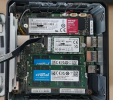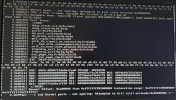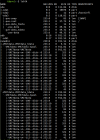Hi,
I am freaking out a bit, because this happened when I need it the least ...
A few month ago, I turned off my last raspberry pi and migrated everything to PVE. For that purpose built a server using the following (brand new) components:
- Intel NUC 12 Pro Kit NUC12WSHI70Z(Intel Core i7 , 1260P)
- 2x Crucial Laptop Memory, SO-DIMM, DDR4, 32GB, 3200MHz
- Transcend MTS420S (120 GB, M.2 2242) as system disk
- WD Red SN700 NVMe M.2 - 1TB as VM storage drive

I installed PVE (I can't tell which version, because it is not booting up anymore, but it must have been a version I downloaded ~ mid of March) and used the Transcend SSD as system drive and put the VMs on the WD red NVMe.
Later I connected my NAS via NFS and set up a PBS as virtual machine. The NAS was mounted via NFS on the PBS server.
Then I configured a bunch of virtual machines and containers and configured nightly backups via the PBS.
Backups were run nightly of containers and once per week of every VM and stored on my NAS via the PBS.
The server was running continuously for a couple of months without issues. From time to time I did a apt-get update/upgrade, last time I did that was probably two days ago. However, there were actually no updates for quite a while, so I think it might auto update from time to time(?).
Now I had my NAS turned off for a few days (therefore no recent backups were done - no big issue). Today I turned it back on and since I configured a few things in some containers, I run a backup job.
Approx. half an hour later I noticed that the PVE was not working anymore. I had to reboot it by pressing the power button and then I got this screen:

What I did so far:
- rebooted --> (same thing)
- run a memory test --> (doesn't show anything on the screen ... just a black screen ...)
- took out a memory bar at a time and booted --> (same thing)
- downloaded PVE 8.0-2 and booted in the recovery mode --> (same thing)
I guess there is no way to recover the current installation?
I guess I have to reinstall everything?
To be safe, should I order a new system SSD in case it is a hardware issue?
If I have to reinstall everything, could anyone point me to some instructions on how to recover the VMs/containers? They should be on the WD Red NVMe and in principle on my NAS as backup from the PBS.
However, I find plenty of instructions on the web on how to restore VMs and containers from backups, but no instruction on how to restore everything in case the PVE fails.
What I would have to restore is:
- The PVE installation
- The volumes on the WD Red NVMe and the VMs re-added to PVE (I don't know how, does PVE recognize automatically that there are VMs/containers on or do I have to import them somehow?)
- all the PVE configurations (users, backup plans, mount points etc.)
- The PBS setup ...
Are there any instructions on how to do that efficiently and without e.g. reformatting the WD Red NVMe?
This also raises the question for me why it is possible to backup all VMs/containers but not the actual PVE with all its settings? Is there a way to do that in the future?
Thanks a lot!
Best,
I am freaking out a bit, because this happened when I need it the least ...
A few month ago, I turned off my last raspberry pi and migrated everything to PVE. For that purpose built a server using the following (brand new) components:
- Intel NUC 12 Pro Kit NUC12WSHI70Z(Intel Core i7 , 1260P)
- 2x Crucial Laptop Memory, SO-DIMM, DDR4, 32GB, 3200MHz
- Transcend MTS420S (120 GB, M.2 2242) as system disk
- WD Red SN700 NVMe M.2 - 1TB as VM storage drive

I installed PVE (I can't tell which version, because it is not booting up anymore, but it must have been a version I downloaded ~ mid of March) and used the Transcend SSD as system drive and put the VMs on the WD red NVMe.
Later I connected my NAS via NFS and set up a PBS as virtual machine. The NAS was mounted via NFS on the PBS server.
Then I configured a bunch of virtual machines and containers and configured nightly backups via the PBS.
Backups were run nightly of containers and once per week of every VM and stored on my NAS via the PBS.
The server was running continuously for a couple of months without issues. From time to time I did a apt-get update/upgrade, last time I did that was probably two days ago. However, there were actually no updates for quite a while, so I think it might auto update from time to time(?).
Now I had my NAS turned off for a few days (therefore no recent backups were done - no big issue). Today I turned it back on and since I configured a few things in some containers, I run a backup job.
Approx. half an hour later I noticed that the PVE was not working anymore. I had to reboot it by pressing the power button and then I got this screen:

What I did so far:
- rebooted --> (same thing)
- run a memory test --> (doesn't show anything on the screen ... just a black screen ...)
- took out a memory bar at a time and booted --> (same thing)
- downloaded PVE 8.0-2 and booted in the recovery mode --> (same thing)
I guess there is no way to recover the current installation?
I guess I have to reinstall everything?
To be safe, should I order a new system SSD in case it is a hardware issue?
If I have to reinstall everything, could anyone point me to some instructions on how to recover the VMs/containers? They should be on the WD Red NVMe and in principle on my NAS as backup from the PBS.
However, I find plenty of instructions on the web on how to restore VMs and containers from backups, but no instruction on how to restore everything in case the PVE fails.
What I would have to restore is:
- The PVE installation
- The volumes on the WD Red NVMe and the VMs re-added to PVE (I don't know how, does PVE recognize automatically that there are VMs/containers on or do I have to import them somehow?)
- all the PVE configurations (users, backup plans, mount points etc.)
- The PBS setup ...
Are there any instructions on how to do that efficiently and without e.g. reformatting the WD Red NVMe?
This also raises the question for me why it is possible to backup all VMs/containers but not the actual PVE with all its settings? Is there a way to do that in the future?
Thanks a lot!
Best,


